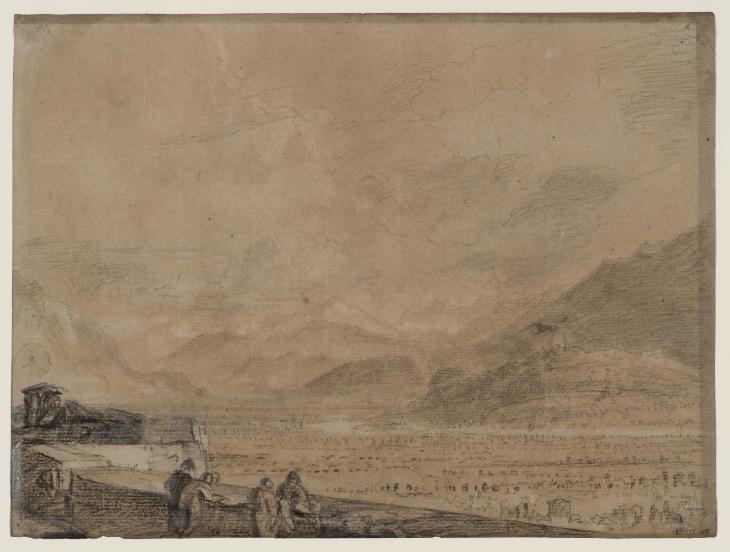Joseph Mallord William Turner Grenoble and the Grésivaudan from the Donjon below the Bastille 1802
Joseph Mallord William Turner,
Grenoble and the Grésivaudan from the Donjon below the Bastille
1802
Joseph Mallord William Turner 1775–1851
Grenoble and the Grésivaudan from the Donjon below the Bastille 1802
D04495
Turner Bequest LXXIV 3
Turner Bequest LXXIV 3
Pencil, black chalk and white gouache on greyish-buff laid paper, 210 x 284 mm
Stamped in black ‘LXXIV 3’ bottom right
Blind-stamped with the Turner Bequest monogram bottom right
Stamped in black ‘LXXIV 3’ bottom right
Blind-stamped with the Turner Bequest monogram bottom right
Accepted by the nation as part of the Turner Bequest 1856
Exhibition history
1857
Marlborough House, London, 1857 (30 II, as ‘Mont Blanc, seen up the Val d’Isère, from Fort St. Louis’).
1878
National Gallery, London, various dates from 1878 to 1904 (545b).
1998
Turner in the Alps 1802, Tate Gallery, London, November 1998–February 1999, Fondation Pierre Gianadda, Martigny, March–June 1999 (9, as ‘Above Grenoble: The Isère Valley...’).
References
1859
John Burnet and Peter Cunningham, Turner and his Works: Illustrated with Examples from his Pictures, and Critical Remarks on his Principles of Painting, 2nd ed., revised by Henry Murray, London 1859, p.116 no.30 II, as ‘Mont Blanc, seen up the Val d’Isère, from Fort St. Louis’.
1862
Walter Thornbury, The Life of J.M.W. Turner, R.A. Founded on Letters and Papers Furnished by his Friends and Fellow-Academicians, London 1862 [1861], p.389.
1897
Walter Thornbury, The Life of J.M.W. Turner, R.A. Founded on Letters and Papers Furnished by his Friends and Fellow-Academicians: A New Edition, Revised with 8 Coloured Illustrations after Turner’s Originals and 2 Woodcuts, London 1897, p.585.
1902
E.T. Cook (ed.), Ruskin on Pictures: A Collection of Criticisms by John Ruskin not heretofore Re-printed and now Re-edited and Re-arranged, London 1902, vol.I, p.226.
1904
E.T. Cook and Alexander Wedderburn (eds.), Library Edition: The Works of John Ruskin: Volume XIII: Turner: The Harbours of England; Catalogues and Notes, London 1904, pp.265, 634.
1909
A.J. Finberg, A Complete Inventory of the Drawings of the Turner Bequest, London 1909, vol.I, p.197, LXXIV 3.
1998
David Blayney Brown, Turner in the Alps 1802, exhibition catalogue, Tate Gallery, London 1998, pp.54–5 reproduced in colour, as ‘Above Grenoble: The Isère Valley...’.
1999
David Blayney Brown, Turner et les Alpes 1802, exhibition catalogue, Fondation Pierre Gianadda, Martigny 1999, pp.54–5 reproduced in colour.
For Turner’s visit to Grenoble in 1802 see Introduction to the sketchbook. He spent three or four days in the city and used it as a base for exploring the surrounding scenery. Most of his more finished drawings of the city come from this book; there are quicker sketches in the France, Savoy, Piedmont sketchbook (Tate D04488, D04490; Turner Bequest LXXIII 76a, 77a).
Turner’s label for this drawing is inscribed ‘Mt Blanc Val de Iser from le fort de Louis’. The view looks eastwards along the Grésivaudan or Valley of Grenoble from the donjon wall below the Bastille, known at the time of Turner’s visit in 1802 as the ‘Fort de Louis’. As Turner saw them, the fortifications were decayed but otherwise little changed from those built up during the reign of Louis XIII at the beginning of the seventeenth century by the governor of the Dauphiné, Marshall Lesdiguières. They were later remodelled by General Haxo, 1823–47.
The city lies below. Just visible, on the right, is the fourteenth-century Tour de l’Île, part of the old city fortifications which had housed the French army of occupation in 1792, and perhaps the belfry of the Cathedral. In the distance, the River Isère meanders along the valley, marked by Turner in white. Beyond, to the right, are the village of St Martin d’Hères and the forest of St Martin d’Uriage. The distant mountains include the Belledonne range, with the Pic de Chamrousse and the Pic du Grand Colon, but perhaps not Mont Blanc as Turner supposed. For observations on this drawing, the author is grateful to Roland Courtot of the University of Aix-en-Provence.1
John Ruskin’s catalogue notes on this drawing, when it was exhibited at Marlborough House, observed that
when Turner wants to give value to a vertical line he adds verticalness somewhere else; and when he wants to insist on a graceful one, adds gracefulness somewhere else. So here, wanting to insist on the plain’s flatness, he adds flatness in the walls. He always attached infinitely more value to sympathy than to contrast; it was one of his leading principles as a composer.2
Turner included ‘15 Fort Lewis’ in a list of French and Swiss subjects on the back of a random pencil sketch (Tate D08253; Turner Bequest CXX m). However, no other version of this subject is known.
Verso:
Blank, save for inscription by Turner in pencil, ‘Vale of the Iser with M Blanc’
David Blayney Brown
March 2012
How to cite
David Blayney Brown, ‘Grenoble and the Grésivaudan from the Donjon below the Bastille 1802 by Joseph Mallord William Turner’, catalogue entry, March 2012, in David Blayney Brown (ed.), J.M.W. Turner: Sketchbooks, Drawings and Watercolours, Tate Research Publication, August 2014, https://www

